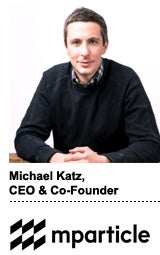This is the first in AdExchanger’s “Meet the CDPs” series. Read other interviews with Acquia-owned AgilOne, Amperity, Segment, ActionIQ, Lytics, Bluecore, Microsoft, Tealium, Optimove, Adobe, Treasure Data and BlueConic.
When mParticle was founded in 2012, the moniker “customer data platform” didn’t exist yet. David Raab, founder of the CDP Institute, wouldn’t coin the term until 2013.
And so mParticle jury-rigged a new category for itself in the interim: mobile data automation platform. At the time, heavy-hitters in the DMP space razzed the concept. Krux CEO and co-founder Tom Chavez wrote a column for AdExchanger in which he contended that “mobile anything is ill posed.”
But Michael Katz, mParticle’s CEO and co-founder, argues that mParticle was a fully-fledged CDP from Day One.
MParticle started with mobile data, because mobile is “the center of mass for the customer experience,” Katz said. The company has since expanded to connecting consumer data from across channels, including point-of-sale and in-store data.
Today, mParticle has several hundred enterprise clients, including Airbnb, JetBlue, Walmart, Adidas, Spotify, Viacom, Disney, Dunkin’, Burger King, Supercell and Postmates.
AdExchanger caught up with Katz.
AdExchanger: Who is your typical customer, and what problem are they trying to solve?
MICHAEL KATZ: We typically only work with multichannel consumer brands, no B2B brands. This allows us to focus on creating a better solution for the types of companies in our addressable market. Our main focus is making it easier for brands to ensure data quality throughout the stack in order to deliver better customer experiences while ensuring privacy.
For consumer brands, streaming data to and from various sources and systems in real time is fundamentally important. One, because of how fast consumers move, but also because data quality is the foundation for success. The customer experience can only ever be as good as the data that feeds into the systems that help provide it.
The main thing brands want to do is build a flexible, scalable and secure stack. MParticle is the foundational tool they need to do that. Without it, there’s no great way to ensure data consistency or quality across the entire stack.
Who are your biggest competitors?
Historically, the biggest competition we’ve seen is when companies either do nothing or try to use legacy solutions to solve modern data challenges.
From an external competition standpoint, the only company we see regularly is Segment, although it’ll be interesting to see what happens with the marketing cloud vendors. They’re so far behind the rest of the market and we’ve yet to see solutions or even proposed solutions that should be taken very seriously.
Sounds like you’re not all that impressed with marketing clouds getting into the CDP space.
Honestly, it’s good for the space. Beyond awareness, it creates validation for companies like us who had this vision seven years ago.
Beyond that, it’s TBD in terms of how strong their execution will be. These companies have an incredible market presence and decades of experience working with certain customers. But I’d also question their track record on innovation over the last few years. They have a much better track record on M&A.
How does your product differentiate from your competitors?
From Day One it was about being built for the enterprise and creating a secure and reliable solution for customer data management. As we’ve evolved, we’re focused on data quality, both in terms of integrity as well as our investment in identity resolution. Another big differentiator for us is the breadth and depth of the integration ecosystem we support. We want to provide full-fidelity support for any integration. There should be no limitations or additional friction standing in the way of you connecting your data to your favorite APIs.
How long does it take to onboard a new customer?
It really depends. If a customer has a single app and a website, it’s relatively straightforward and could take days or weeks. But we work with some companies that have dozens of brands spread across the globe with multiple properties across multiple platforms. That type of deployment won’t ever happen in a couple of days, weeks or even months. It could take a year or more to get fully deployed.
How do you convince customers to stick it out for what could be a multiyear integration process?
A few years ago, we had to evangelize the idea that there is a better way to connect customer data. Today, most people understand the opportunity of a single point of integration with connectors out to all of the different tools they use across the functions of their business to ultimately drive ROI and customer lifetime value. They get it.
What data sources do you commonly connect?
We always start with mobile app data. But to create a single view of the customer requires data from the web and other screens. On the commerce side, that includes transaction and payment data, maybe POS data and other in-store retail data. On the media and content side, that includes connected device data, like the Xbox, Roku, Apple TV, what have you.
How much money have you raised?
We’ve raised $121 million.
How many employees do you have, and what percentage are in engineering?
We’re at around 140 people and 40% are product and engineering, and we’re planning to hire more.
What is your biggest advantage, and how will you maintain it over the next three to five years?
We get a really good look at what’s under the hood at some of the biggest, best and most innovative companies in the world, and because we’ve been doing this and only this for so long, we’re able to attract some really forward-looking brands.
The conversations we have with our clients have helped us build the capabilities we have today and to create a road map and a path toward a differentiated future. Some of the newer entrants in the space are playing catch up.
This interview has been edited and condensed.












